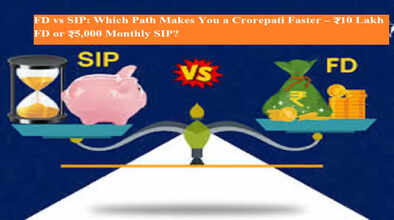FD vs SIP: Which Path Makes You a Crorepati Faster – ₹10 Lakh FD or ₹5,000 Monthly SIP?

If your goal is to build a corpus of ₹1 crore, you might be wondering: should you invest ₹10 lakh in a Fixed Deposit (FD) or start a ₹5,000 monthly SIP (Systematic Investment Plan)? Both are popular investment routes, but the journey, risk, and returns they offer differ significantly. Here's a detailed breakdown to help you decide which strategy is likely to make you a crorepati faster.
Understanding FD: Safe but Slow Growth
A Fixed Deposit is a traditional and secure investment option where you park a lump sum for a fixed period at a pre-decided interest rate. Currently, FDs offer an average interest rate of around 7% per annum. The best part about an FD is its stability – your money is safe, returns are guaranteed, and there’s no impact of market fluctuations.
Benefits of FD:
-
Guaranteed returns
-
No market-linked risk
-
Senior citizens get extra interest
-
Ideal for risk-averse investors
Drawbacks:
-
Lower returns (typically 6–7% per annum)
-
Returns often fail to beat inflation
-
Interest is taxable
-
Very slow long-term growth
How Long Will It Take to Turn ₹10 Lakh FD Into ₹1 Crore?
Assuming a constant 7% annual interest compounded annually and no withdrawal during the tenure, here’s the timeline:
| Years | Maturity Amount |
|---|---|
| 10 | ₹19.67 lakh |
| 15 | ₹27.59 lakh |
| 20 | ₹38.70 lakh |
| 25 | ₹54.23 lakh |
| 30 | ₹76.12 lakh |
| 33.5 | ₹1 crore |
So, it would take 33.5 years for your ₹10 lakh FD to grow to ₹1 crore — assuming stable rates and no taxation on interest. That’s a long wait!
SIP: Small Steps, Big Dreams
SIP allows you to invest a fixed amount regularly into mutual funds. Equity-based SIPs are linked to the stock market and, while volatile in the short term, have historically delivered 12% average annual returns over the long term.
Advantages of SIP:
-
Start with as low as ₹500
-
Power of compounding is higher due to monthly contributions
-
Flexible – can start, pause, or stop anytime
-
Lower long-term capital gains tax
Risks:
-
Returns are not guaranteed
-
Completely market-linked
-
Requires long-term discipline and patience
How Fast Can ₹5,000 Monthly SIP Grow to ₹1 Crore?
Assuming a 12% average annual return:
| Duration | Total Invested | Corpus Value |
|---|---|---|
| 20 years | ₹12 lakh | ₹34.88 lakh |
| 25 years | ₹15 lakh | ₹67.28 lakh |
| 29 years | ₹17.4 lakh | ₹1 crore |
| 30 years | ₹18 lakh | ₹1.53 crore |
So, a ₹5,000 SIP can make you a crorepati in 29 years. And if you continue for 33.5 years — same as the FD — the corpus could grow to over ₹2.7 crore, almost three times more than what FD would yield in the same period.
Moreover, if your SIP fetches 15% annual return (possible with high-performing equity funds), the ₹1 crore mark can be achieved in just 21 years and 4 months — that’s over 12 years earlier than FD.
FD vs SIP: Which is Right for You?
| Factor | Fixed Deposit | SIP |
|---|---|---|
| Risk Level | Very Low | Moderate to High |
| Returns | 6–7% | 12–15% (equity-based) |
| Lock-in Period | Fixed | Flexible |
| Taxation | Interest Taxed | LTCG tax (after ₹1 lakh) |
| Suitable For | Capital safety | Long-term wealth building |
If capital preservation and zero risk are your top priorities, FD might suit you. But building ₹1 crore will take over three decades — a very slow approach.
On the other hand, if you can tolerate market risks and stay invested long-term, SIP offers faster, more powerful returns with lower monthly investments.
Conclusion
A ₹10 lakh FD will take nearly 33.5 years to become ₹1 crore, while a ₹5,000 SIP can reach the same milestone in 29 years — or even earlier if markets perform well. SIP clearly has the edge when it comes to long-term wealth creation through disciplined investing.
Bottom Line: If you want to become a crorepati faster and can handle some market volatility, SIP is the better choice. But always consult a financial advisor before making investment decisions.
Disclaimer: This article is for informational purposes only and not financial advice. All investments are subject to market risk. Please consult a certified financial advisor before investing.

